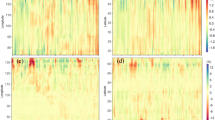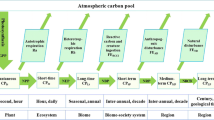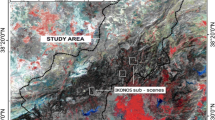Abstract
Quantifying the spatial and temporal dynamics of carbon stocks in terrestrial ecosystems and carbon fluxes between the terrestrial biosphere and the atmosphere is critical to our understanding of regional patterns of carbon budgets. Here we use the General Ensemble biogeochemical Modeling System to simulate the terrestrial ecosystem carbon dynamics in the **sha watershed of China’s upper Yangtze basin from 1975 to 2000, based on unique combinations of spatial and temporal dynamics of major driving forces, such as climate, soil properties, nitrogen deposition, and land use and land cover changes. Our analysis demonstrates that the **sha watershed ecosystems acted as a carbon sink during the period of 1975–2000, with an average rate of 0.36 Mg/ha/yr, primarily resulting from regional climate variation and local land use and land cover change. Vegetation biomass accumulation accounted for 90.6% of the sink, while soil organic carbon loss before 1992 led to a lower net gain of carbon in the watershed, and after that soils became a small sink. Ecosystem carbon sink/source patterns showed a high degree of spatial heterogeneity. Carbon sinks were associated with forest areas without disturbances, whereas carbon sources were primarily caused by stand-replacing disturbances. It is critical to adequately represent the detailed fast-changing dynamics of land use activities in regional biogeochemical models to determine the spatial and temporal evolution of regional carbon sink/source patterns.






Similar content being viewed by others
References
Achard F, Eva HD, Mayaux P, Stibig HJ, Belward A (2004) Improved estimates of net carbon emissions from land cover change in the tropics for the 1990s. Global Biogeochemical Cycles 18:GB2008. doi:10.1029/2003GB002142
Bala G, Caldeira K, Wickett M, Phillips TJ, Lobell DB, Delire C, Mirin A (2007) Combined climate and carbon-cycle effects of large-scale deforestation. Proceedings of the National Academy of Sciences of the United States of America 104:6550–6555
Binford MW, Gholz HL, Starr G, Martin TA (2006) Regional carbon dynamics in the southeastern U.S. coastal plain: balancing land cover type, timber harvesting, fire, and environmental variation. Journal of Geophysical Research-Atmospheres 111:D24S92. doi:10.1029/2005JD006820
Canadell JG (2002) Land use effects on terrestrial carbon sources and sinks. Science in China Series C-Life Sciences 45:1–9
Cao MK, Prince SD, Small J, Goetz SJ (2004) Remotely sensed interannual variations and trends in terrestrial net primary productivity 1981–2000. Ecosystems 7:233–242
Chapin FS, Woodwell GM, Randerson JT, Rastetter EB, Lovett GM, Baldocchi DD, Clark DA, Harmon ME, Schimel DS, Valentini R, Wirth C, Aber JD, Cole JJ, Goulden ML, Harden JW, Heimann M, Howarth RW, Matson PA, Mcguire AD, Melillo JM, Mooney HA, Neff JC, Houghton RA, Pace ML, Ryan MG, Running SW, Sala OE, Schlesinger WH, Schulze ED (2006) Reconciling carbon-cycle concepts, terminology, and methods. Ecosystems 9:1041–1050
Choi SD, Lee K, Chang YS (2002) Large rate of uptake of atmospheric carbon dioxide by planted forest biomass in Korea. Global Biogeochemical Cycles 16:1089. doi:10.1029/2002GB001914
Conservation International (2002) Biodiversity hotspots. http://www.biodiversityhotspots.org/xp/hotspots/China
Davidson EA, Janssens IA (2006) Temperature sensitivity of soil carbon decomposition and feedbacks to climate change. Nature 440:165–173
Editorial Committee for Panzhihua Statistical Yearbook (ECPSY) (2002) Panzhihua’s statistical yearbook from 1987 to 2001. Statistical Bureau of Panzhihua, Sichuan
Fang JY, Chen AP, Peng CH, Zhao SQ, Ci L (2001a) Changes in forest biomass carbon storage in China between 1949 and 1998. Science 292:2320–2322
Fang JY, Piao SL, Tang ZY, Peng CH, Wei J (2001b) Interannual variability in net primary production and precipitation. Science 293:1723a
Fang JY, Piao SL, Field CB, Pan YD, Guo QH, Zhou LM, Peng CH, Tao S (2003) Increasing net primary production in China from 1982 to 1999. Frontier in Ecology and the Environment 1:293–297
Fang JY, Oikawa T, Kato T, Mo WH, Wang ZH (2005) Biomass carbon accumulation by Japan’s forests from 1947 to 1995. Global Biogeochemical Cycles 19:GB2004. doi:10.1029/2004GB002253
Foley JA, Defries R, Asner GP, Barford C, Bonan G, Carpenter SR, Chapin FS, Coe MT, Daily GC, Gibbs HK, Helkowski JH, Holloway T, Howard EA, Kucharik CJ, Monfreda C, Patz JA, Prentice IC, Ramankutty N, Snyder PK (2005) Global consequences of land use. Science 309:570–574
Gimona A, Birnie RV, Sibbald AR (2006) Scaling up of a mechanistic dynamic model in a GIS environment to model temperate grassland production at the regional scale. Grass and Forage Science 61:315–331
Houghton RA (2003) Revised estimates of the annual net flux of carbon to the atmosphere from changes in land use and land management 1850–2000. Tellus B 55:378–390
Houghton RA, Goodale CL (2004) Effects of land-use change on the carbon balance of terrestrial ecosystems. In: DeFries RS, Asner GP, Houghton RA (eds) Ecosystems and land use change. American Geophysical Union, Washington, DC, pp 85–98
Iverson LR, Dale ME, Scott CT, Prasad A (1997) A GIS-derived integrated moisture index to predict forest composition and productivity of Ohio forests (USA). Landscape Ecology 12:331–348
Jenkins JC, Birdsey RA, Pan Y (2001) Biomass and NPP estimation for the mid-Atlantic region (USA) using plot-level forest inventory data. Ecological Applications 11:1174–1193
Jenkinson DS, Adams DE, Wild A (1991) Model estimates of CO2 emissions from soil in response to global warming. Nature 351:304–306
Kauppi PE, Ausubel JH, Fang JY, Mather AS, Sedjo RA, Waggoner PE (2006) Returning forests analyzed with the forest identity. Proceedings of the National Academy of Sciences of the United States of America 103:17574–17579
Liu SG (2009) Quantifying the spatial details of carbon sequestration potential and performance. In: McPherson B, Sundquist E (eds) Science and technology of carbon sequestration. American Geophysical Union (in press)
Liu SG, Bliss N, Sundquist E, Huntington TG (2003) Modeling carbon dynamics in vegetation and soil under the impact of soil erosion and deposition. Global Biogeochemical Cycles 17:1074. doi:10.1029/2002GB002010
Liu SG, Kaire M, Wood E, Diallo O, Tieszen LL (2004a) Impacts of land use and climate change on carbon dynamics in south-central Senegal. Journal of Arid Environments 59:583–604
Liu SG, Loveland TR, Kurtz RM (2004b) Contemporary carbon dynamics in terrestrial ecosystems in the southeastern plains of the United States. Environmental Management 33:S442–S456
Lu XX (2005) Spatial variability and temporal change of water discharge and sediment flux in the lower **sha tributary: impact of environmental changes. River Research and Applications 21:229–243
Magnani F, Mencuccini M, Borghetti M, Berbigier P, Berninger F, Delzon S, Grelle A, Hari P, Jarvis PG, Kolari P, Kowalski AS, Lankreijer H, Law BE, Lindroth A, Loustau D, Manca G, Moncrieff JB, Rayment M, Tedeschi V, Valentini R, Grace J (2007) The human footprint in the carbon cycle of temperate and boreal forests. Nature 447:848–850
Meyer WB, Turner BL (1992) Human-population growth and global land-use cover change. Annual Review of Ecology and Systematics 23:39–61
Nemani RR, Keeling CD, Hashimoto H, Jolly WM, Piper SC, Tucker CJ, Myneni RB, Running SW (2003) Climate-driven increases in global terrestrial net primary production from 1982 to 1999. Science 300:1560–1563
Pan YD, Melillo JM, Mcguire AD, Kicklighter DW, Pitelka LF, Hibbard K, Pierce LL, Running SW, Ojima DS, Parton WJ, Schimel DS (1998) Modeled responses of terrestrial ecosystems to elevated atmospheric CO2: a comparison of simulations by the biogeochemistry models of the Vegetation/ecosystem modeling and analysis project (Vemap). Oecologia 114:389–404
Potter CS, Randerson JT, Field CB, Matson PA, Vitousek PM, Mooney HA, Klooster SA (1993) Terrestrial ecosystem production: a process model based on global satellite and surface data. Global Biogeochemical Cycles 7:811–842
Pregitzer KS, Euskirchen ES (2004) Carbon cycling and storage in world forests: biome patterns related to forest age. Global Change Biology 10:2052–2077
Ramankutty N, Gibbs HK, Achard F, Defriess R, Foley JA, Houghton RA (2007) Challenges to estimating carbon emissions from tropical deforestation. Global Change Biology 13:51–66
Rustad LE, Campbell JL, Marion GM, Norby RJ, Mitchell MJ, Hartley AE, Cornelissen JHC, Gurevitch J (2001) A meta-analysis of the response of soil respiration, net nitrogen mineralization, and aboveground plant growth to experimental ecosystem warming. Oecologia 126:543–562
Schimel DS, House JI, Hibbard KA, Bousquet P, Ciais P, Peylin P, Braswell BH, Apps MJ, Baker D, Bondeau A, Canadell J, Churkina G, Cramer W, Denning AS, Field CB, Friedlingstein P, Goodale C, Heimann M, Houghton RA, Melillo JM, Moore B, Murdiyarso D, Noble I, Pacala SW, Prentice IC, Raupach MR, Rayner PJ, Scholes RJ, Steffen WL, Wirth C (2001) Recent patterns and mechanisms of carbon exchange by terrestrial ecosystems. Nature 414:169–172
Shi XZ, Yu DS (2002) A framework for the 1:1,000,000 soil database of China. In: Proceedings of the 17th world congress of soil science, Bangkok
Tian HQ, Melillo JM, Kicklighter DW, Mcguire AD, Helfrich JVK, Moore B, Vorosmarty CJ (1998) Effect of interannual climate variability on carbon storage in Amazonian ecosystems. Nature 396:664–667
Tickle PK, Coops NC, Hafner SD (2001) Assessing forest productivity at local scales across a native Eucalypt forest using a process model, 3PG-Spatial. Forest Ecology and Management 152:275–291
Vitousek PM, Mooney HA, Lubchenco J, Melillo JM (1997) Human domination of earth’s ecosystems. Science 277:494–499
**ang Q, Yin RS, Xu JT, Deng XZ (2008) Modeling the driving forces of the land use/cover changes along the upper Yangtze River of China. Environmental Management (under review)
Zhao SQ, Peng CH, Jiang H, Tian DL, Lei XD, Zhou XL (2006) Land use change in Asia and the ecological consequences. Ecological Research 21:890–896
Acknowledgments
This study was funded by the US National Science Foundation (project #0507948), and U.S. Geological survey's Geographic Analysis and Monitoring (GAM) and the Earth Surface Dynamics (ESD) programs. S. Zhao acknowledges the support of the outstanding young Fellow program of Peking University. Logistical support from Sichuan Agricultural University is gratefully acknowledged.
Author information
Authors and Affiliations
Corresponding author
Rights and permissions
About this article
Cite this article
Zhao, S., Liu, S., Yin, R. et al. Quantifying Terrestrial Ecosystem Carbon Dynamics in the **sha Watershed, Upper Yangtze, China from 1975 to 2000. Environmental Management 45, 466–475 (2010). https://doi.org/10.1007/s00267-009-9285-9
Received:
Revised:
Accepted:
Published:
Issue Date:
DOI: https://doi.org/10.1007/s00267-009-9285-9




